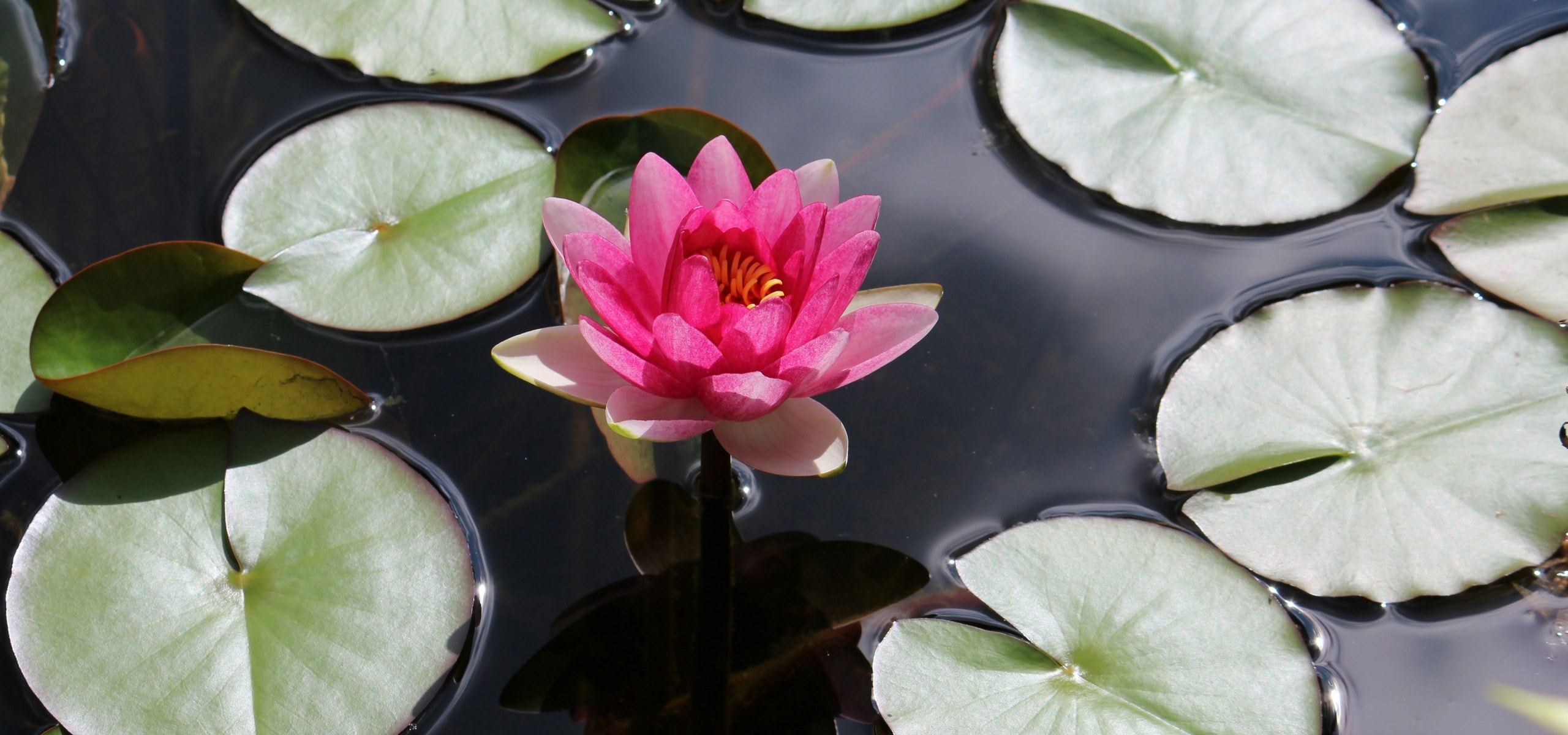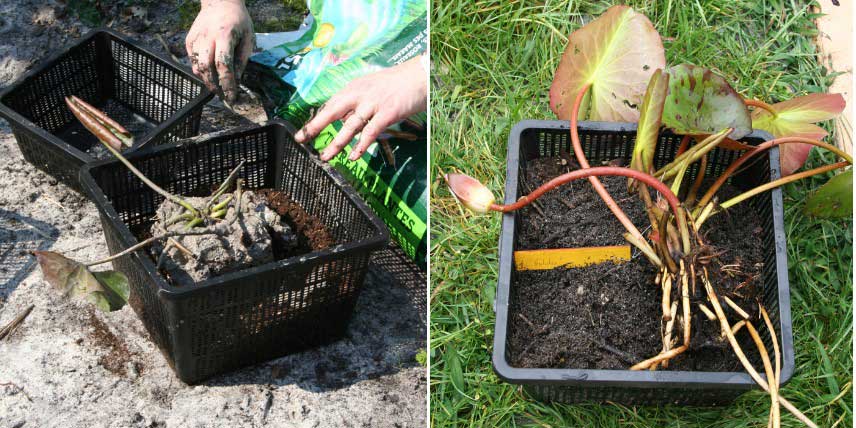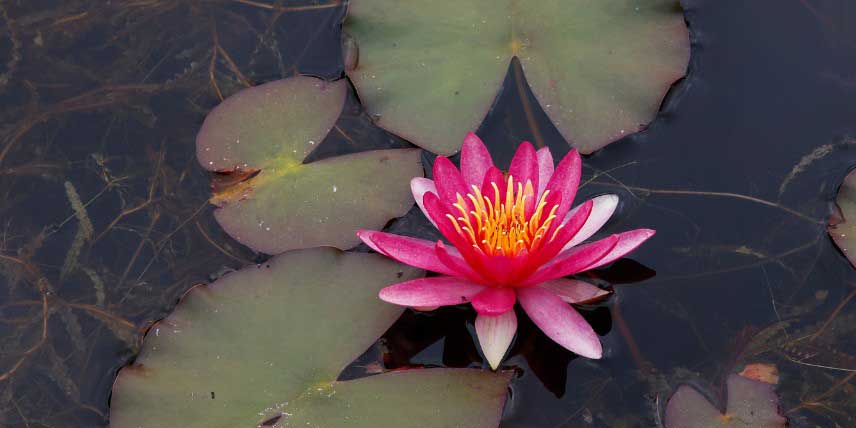
Planting water lilies
in a pond or in a pot
Contents
The water lilies, belonging to the genus Nymphaea, are iconic aquatic plants in water gardens. With their large floating leaves and majestic flowers, they bring a touch of beauty and serenity to any pond. Known for their spectacular flowers, often compared to stars on the water, water lilies are available in several varieties, offering a palette of colours ranging from pure white to pink, yellow, and even blue. Furthermore, water lilies contribute to the balance of the aquatic ecosystem by providing shade, which reduces algae proliferation, and offering a habitat for various species of aquatic wildlife.
Choosing the right location, the appropriate substrate, and following the recommended planting techniques are crucial steps for successfully cultivating these magnificent aquatic plants. Discover all our expert tips!
Where to plant the water lily?
Water lilies are aquatic plants that should be planted in spring in a pond at least 50 cm deep to provide a stable environment and promote optimal growth. Ideally, planting should be at a depth of 60 to 85 cm.
Water lilies need six to eight hours of sunlight per day to thrive. Avoid overly shaded areas, as this may limit their ability to flower.
The pH of the water should be between 6.5 and 7.5. An inappropriate pH can lead to growth problems and make water lilies more susceptible to diseases and pests. It is recommended to regularly test the pH of the water and make necessary adjustments to maintain optimal conditions.
Good to know: The floating leaves of water lilies also play an important role in providing shade for fish and reducing algae growth by limiting the light that penetrates the water.
To learn more about growing Nymphaea, read Nymphea, water lily: planting and caring for.

Nymphaea ‘Starbright’
Read also
How to divide a water lily?When to plant water lilies?
The best time to plant water lilies is in spring, between April and June, when temperatures begin to warm up and the risk of frost has passed. Planting during this time allows water lilies to benefit from a full growth season, giving them enough time to root and establish before winter.
What substrate is suitable for water lily?
Planting in a Pond
In a natural pond where the bottom is muddy, water lilies can be planted directly in the mud. The mud provides a stable anchor and a constant source of nutrients for the roots of the water lilies. It is rich in organic matter, which promotes the growth of aquatic plants. However, it is essential to ensure that the mud is not too compacted to allow for good circulation of water and oxygen around the roots.
Planting in Pots or Baskets
For cultivation in pots or submerged baskets, a specific substrate must be used to ensure the health and flowering of the water lilies. Use good garden soil, even heavy, mixed with coarse sand. The sand helps prevent the substrate from becoming too compact. Avoid using standard potting soil, as it often contains lightweight organic matter that floats and encourages algae growth.
To prevent algae growth in water lily ponds, ensure that the water lilies sufficiently cover the surface of the water to shade it. Balance nutrients by using fertilisers in moderation and avoid overfeeding fish. Finally, maintain good water circulation with pumps or aerators and introduce competing aquatic plants.

Planting a water lily in a perforated basket, which will then be submerged in water.
Read also
Nymphea, water lily: planting and careHow to plant water lilies?
Preparation of Rootstocks
Upon receipt, inspect them to ensure they are in good condition, with no signs of rot or disease. Carefully cut away any damaged or dead parts with a clean, sharp knife. If you cannot plant the rootstocks immediately, store them in a cool, dark place, wrapping them in a damp cloth to prevent them from drying out. Avoid exposing them to direct sunlight to prevent desiccation.
Planting in Mud or in Baskets
To plant water lilies in a muddy pond, you can simply push the rootstocks directly into the mud. Weigh them down with a stone to keep them in place until they are well-rooted.
If you choose to grow in pots or baskets, follow these steps:
- Choosing the Container: Use a pot or a mesh basket with fine mesh at least 40 cm in diameter to allow for good root growth.
- Preparing the Substrate: Fill the container with heavy garden soil mixed with coarse sand.
- Planting the Rootstock: Plant the rootstock vertically in the substrate, ensuring that the collar is just below the surface. The growth buds should point upwards.
- Weighing Down the Substrate: Add some gravel or small stones on top of the substrate to weigh it down and prevent it from being washed away by water movement.
- Watering: Water generously to compact the substrate around the rootstock.
Spacing of Plants
Water lilies need space to grow. A spacing of at least 1.5 metres between plants is recommended. This allows the floating leaves to spread and the flowers to bloom fully without obstruction.
Gradual Immersion
Once the rootstocks are planted and the pots or baskets are prepared, it is essential to gradually immerse the water lilies in the pond. This technique helps the plants adapt to changes in pressure and temperature. Follow these steps for gradual immersion:
- Initial Positioning: Place the pot or basket at a shallow depth, so that the top of the rootstock is just below the water surface.
- Gradual Immersion: Over a period of a few days to a week, gradually move the pot or basket to deeper areas of the pond, until reaching the recommended final depth of 60 to 85 cm.
- Observation: During this period, observe the plants for any signs of stress or poor adaptation, and adjust the depth if necessary.
Please note: Each year, at the beginning of the growing season, you can distribute a special fertiliser for aquatic plants.

Nymphaea ‘Newton’
- Subscribe!
- Contents






























